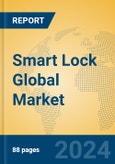Market Size and Growth Forecast
The global smart lock market is estimated at USD 3.1 billion to USD 3.4 billion in 2025, with a CAGR of 2% to 3% from 2025 to 2030, reaching USD 3.5 billion to USD 3.9 billion by 2030.Regional Analysis
Asia Pacific dominates with 80-85% share, growing at 2.5-3.5%, led by China, with trends in affordable, app-enabled locks for urban homes. North America holds 5-10%, growing at 1.5-2.5%, with the U.S. focusing on premium, IoT-integrated locks. Europe has 5-10%, growing at 1.5-2.5%, with Germany favoring high-security designs. MEA grows at 1.0-2%, with 1-2% share, emphasizing commercial use. South America grows at 0.5-1.5%, with 0.5-1% share, focusing on basic smart locks.Application Analysis
Residential dominates with 76.6%, growing at 2.5-3.5%, driven by smart home trends, with a shift toward user-friendly designs. Commercial accounts for 20.5%, growing at 1.5-2.5%, focusing on office security, with trends in keyless access systems. Industrial holds 2.9%, growing at 1.0-2%, with trends in niche, robust applications.Product Type Analysis
Deadbolt locks lead with 70-75%, growing at 2.5-3.5%, valued for security, with trends in biometric integration. Lever handles account for 15-20%, growing at 1.5-2.5%, focusing on ease of use, with trends in commercial adoption. Knob locks hold 5-10%, growing at 1.0-2%, with trends in budget-friendly options.Key Market Players
- ASSA ABLOY: A Swedish giant crafting cutting-edge smart lock solutions.
- Allegion: A U.S. leader enhancing security with innovative locks.
- Dormakaba: A Swiss titan delivering versatile smart locking systems.
- Spectrum Brands: A U.S. firm shaping affordable, tech-savvy locks.
- Kaadas: A Chinese innovator advancing biometric lock technologies.
- DESSMANN: A German expert optimizing secure, smart entry systems.
- Xiaomi: A Chinese visionary blending affordability with smart lock features.
- KinLong HBS: A Chinese specialist enhancing lock durability and design.
- Onity: A U.S. pioneer crafting robust commercial lock solutions.
- Fortune Brands Innovations: A U.S. leader delivering stylish smart locks.
- Salto Systems: A Spanish firm advancing keyless access technologies.
Porter’s Five Forces Analysis
- Threat of New Entrants: Medium. High R&D costs deter entry, but demand lowers barriers for tech firms.
- Threat of Substitutes: Medium. Traditional locks compete, yet smart features sustain their edge.
- Bargaining Power of Buyers: High. Consumers demand affordability and features, leveraging options.
- Bargaining Power of Suppliers: Medium. Component suppliers hold influence, but large players diversify sourcing.
- Competitive Rivalry: High. Firms compete on tech, price, and compatibility, driving innovation.
- Impact of Tariff Conflicts on Supply Chain Localization
Market Opportunities and Challenges
Opportunities
- Smart home boom: Rising IoT adoption drives demand, aligning with convenience trends.
- Urbanization: Growing cities boost residential use, offering mass-market growth.
- Affordability trend: Cost-effective designs expand reach, tapping into emerging markets.
- Security focus: Heightened safety needs enhance appeal, supporting premium applications.
Challenges
- High costs: Advanced tech limits affordability, challenging penetration.
- Substitute competition: Traditional locks threaten share, requiring differentiation.
- Regulatory hurdles: Diverse standards raise compliance costs, slowing expansion.
- Trade disruptions: Tariffs risk supply delays, necessitating adaptive strategies.
This product will be delivered within 1-3 business days.
Table of Contents
Companies Mentioned
- ASSA ABLOY
- Allegion
- Dormakaba
- Spectrum Brands
- Kaadas
- DESSMANN
- Xiaomi
- KinLong HBS
- Onity
- Fortune Brands Innovations
- Salto Systems








